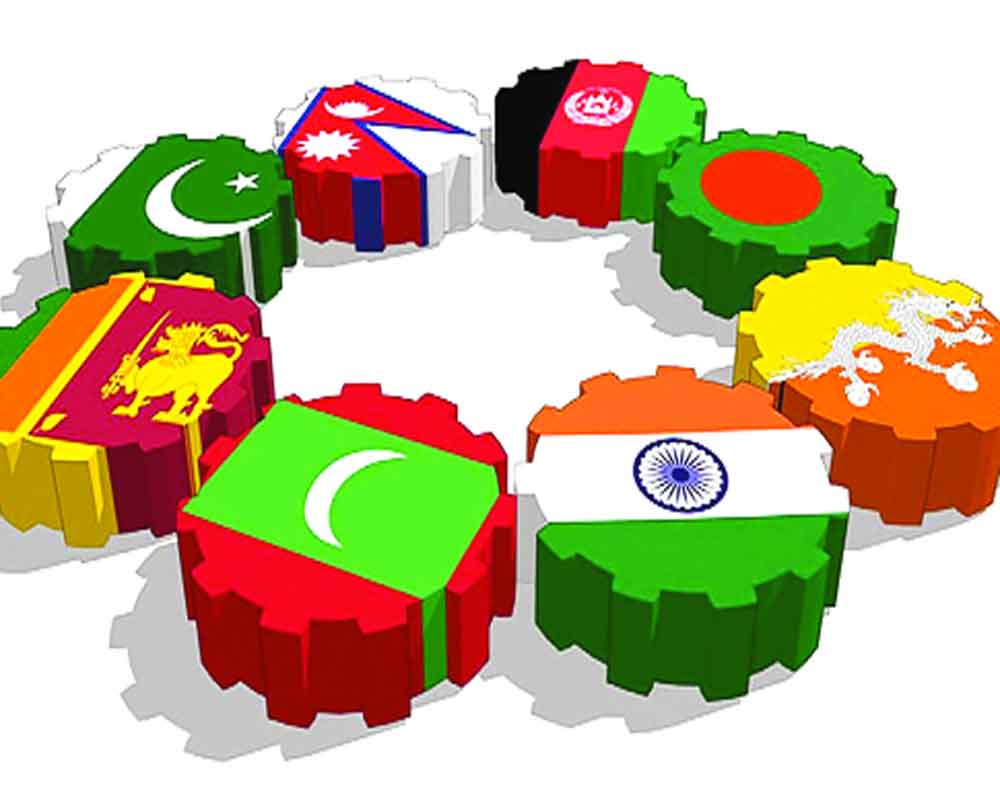ABSTRACT
This paper intends to observe the evolution of the South Asian Region to a more holistic and advanced area while highlighting the role of India in managing the volatile situations and inter-state relations. In South Asian nations, the disruptive effects of imperial penetration on indigenous social structures are still felt.But, the regional cooperation groups have been essential in enlarging the field of influence and improving the political, cultural, and economic ties. India plays a major role in influencing the power dynamics and future of the area due to its central location in South Asia. This research paper examines the crystallisation of South Asian Association for Regional Cooperation (SAARC), India’s hegemony and the China issue. It also identifies the loopholes in the cooperative framework and depicts the journey from self-deprecation to self-realisation over the years. As the paper unfolds, it aims to study India’s relationships with its neighbours, the success or failure of SAARC, and ways to mitigate the obstacles in the path of South Asian integration. This paper deals with two elements, firstly, how India’s rising power status affects the multi ethnic South Asian Region and secondly, the constraints and a transformative way forward to make the region peaceful and prosperous.
KEY WORDS
India, SAARC, China, Pakistan, Maldives, Bhutan, Sri Lanka, Bangladesh, Afghanistan, Nepal, Economy, Policy, Recommendations
LITERATURE REVIEW
India is often perceived as a regional power as it claims to be in charge of more resources than its adjacent nations. Neo-Realist academics stated that having more material wealth inevitably translates into having more control over neighbours, meaning the unequal distribution of hard power resources lead to being a regional power, following the principle of sovereign equality and non-interference.
South Asia is a sizable regional bloc with enormous potential, but it hasn’t accomplished much in terms of economic and political integration. Despite participating in trade, India has long been considered as a barrier in the growth of the smaller states in the area, forcing them to establish contacts with the outside world. To protect the region’s shared interests and transform ambitions into more open systems of peaceful coexistence, supranational organisations like SAARC were established. Later, the dynamic advantages of SAFTA supported restructuring of economies. India’s involvement becomes crucial in the shape of large relief packages and inclusive policies for the recovery and improvement of these nations. A stable economy and the growth of entrepreneurship might aid in lowering the unemployment rates of these lesser-developed nations. India no longer views South Asia as its exclusive backyard and has accepted nations from outside the region as observers in SAARC. Within the SAARC, it seems that the principle of social justice has come to dominate over the ideal of social protection. Elaborated by Adam Smith and Amartya Sen, social development is quite central to sociological understandings of poverty and SAARC. K. Subrahmanyam’s article titled ‘India’s Relations with her Neighbours’, describes how Uncertainty is a defining characteristic of South Asian politics and the importance of India in uniting the neighbours, by respecting the values of freedom, rights, secularism, democracy, federalism and linguistic autonomy.
SOUTH ASIA: ROOTS OF COMMONALITY
South Asia is a place that offers both great risk and amazing potential, a vast and expanding market paves way for a better future despite the region’s struggles with international terrorism, nuclear conflict, social unrest, and humanitarian crises. The history of countries like India, Pakistan, Maldives, Sri Lanka, Bangladesh, Afghanistan, Bhutan and Nepal is marked by the brutal past of Colonial rule, weak civil society and state conflicts. Due to jealousy and rivalry, the momentum of peaceful relations could not be sustained since policy measures lacked coherence and continuity. To combat the neoliberal economic world order, a cooperative security mechanism was required in the area. The South Asian area as a whole is distinguished by shared cultural and civilisational linkages due to similar history, but it also suffers from political turmoil, separatist movements and geopolitical issues, causing ethnic unrest. This led to increase in SAARC’s capacity and readiness to consider options for creating complementary, win-win economic arrangements. It needs to develop a workable structure and realistic terms of reference for substantive collaboration based on mutual benefit.
A TALE OF TWO RIVAL NATIONS- INDIA AND PAKISTAN
India and Pakistan share a bloody past, since Partition both the countries have faced many problems even when collaborating for cooperation. India’s troubles in bilateral relations start from its relationship with Pakistan. The issue of Kashmir remains to be one of the most controversial issues till date. The recent Uri and Pulwama’ attacks have only made matters worse. There have been ups and downs due to territorial and maritime disputes, accusations of cross-border terrorism, disagreements over the sharing of river waters, and curbs on trade.
The foundation of Pakistan on the basis of religion was regarded as a counter-model to the secular Indian state, the ‘unending conflict’ has fostered the supremacy of Pakistan’s army vis-à-vis civilian governments leading to political instability and declining democracy which has further aggravated their hostile relations, hindering development.
With new governments,there was hope of economic improvements, but due to its conflict with India, Pakistan started to intensify its political, economic, and military relations with China. The country often refers to China as an ‘all weather friend’ and describes the bilateral relations as ‘deeper than the ocean and higher than the mountain’. This hostility has been an obstacle in the path of progress of SAARC. The accomplishment of Track II strategy among Pakistan and India has led to territorial improvement, but due to Pakistan’s recent economic crisis, high inflation, and declining economy, India now places a higher priority on border security and has increased its military readiness. As a result, economic relations between the two countries are still buried. The escalating insurrections and separatist movements in Balochistan, which Pakistan accuses India of fomenting, have also deteriorated their relations.
REFUGEE CRISIS- RELATIONS WITH BANGLADESH
India’s military interference in the civil war between East and West Pakistan had resulted in the creation of Bangladesh in 1971. With the inception of Bangladesh, there was a huge flux of refugees that came to India to face less discrimination and live a safe life. The discussion over Bangladesh’s national identity is closely connected with its relations with India that includes the Bengali heritage, language, and culture. After the military coup in 1975, the relationship changed, Bangladesh opened up its economy to western countries, China, and the Gulf states in order to reduce its dependence on India. It promoted the concept of Bangladeshi nationalism, emphasising the role of religion, i.e. Islam, as opposed to the idea of Bengali nationalism.
Bangladesh occupies a key place in India’s Neighbourhood First policy and is the 6th largest trade partner of India having duty free access on all tariff lines except tobacco and alcohol under South Asian Free Trade Area (SAFTA) since 2011. Both the countries need greater cooperation in the Power and Energy Sector to harness their resources efficiently. Tourism also generates revenue for their economies. They are also a part of Bay of Bengal Initiative for Multi-Sectoral Technical and Economic Cooperation (BIMSTEC) and Indian Ocean Rim Association for Regional Cooperation (IORA) which has strengthened their relations. However, there still remain major unresolved issues such as river water disputes, terrorism, aiding illegal immigrants, and drug trades that must be addressed as it has serious implications for its resources and national security.
The ideological battle over national identity was reflected in the recent controversy when the Rohingya refugees originally from Myanmar started infiltrating into India through Bangladesh. The National Register of Citizens (NRC), which is expected to deter future migrants from entering India illegally, has also triggered a major concern in Bangladesh. Growing Chinese Influence in Bangladesh and its active involvement in the Belt and Road Initiative (BRI) has aggravated the problems. There is a need to enhance connectivity in the region, shift focus towards the Comprehensive Economic Partnership Agreement (CEPA), tackle the Refugee Crisis and Counter China’s Influence.
A PEEP INTO NATURE’S BEAUTY- INDIA-BHUTAN AND INDIA- MALDIVES FRIENDSHIP
India has evolved harmonious relations virtually free of bilateral problems with Bhutan and Maldives. Bhutan, the kingdom of happiness, despite being unequal in political and economic terms, has had special relations formalised by the treaty of perpetual peace and friendship signed in 1949. India’s determination to refrain from meddling in Bhutan’s domestic affairs has rendered their relations amicable. Bhutan has committed to import its weapons from or via India on defence-related topics through a mutual agreement that established a bilateral free trade system.
Being a landlocked, underdeveloped country, Bhutan depends heavily on India for its economic assistance. Majority of Bhutan’s external revenue is collected from the sale of electricity to India and it remains a major hub for tourism, though it is seeking to expand its commercial interactions with other countries also. The warm relations have been characterised by strong cultural ties, as both countries are predominantly Buddhist. Bhutan serves as a crucial buffer state for India’s security interests, recent border conflicts and China’s aggression has sparked worries that Bhutan may be drifting away from its longtime ally, India. Bhutan has been negotiating with China over its territorial conflicts, which can endanger India’s security. The problems of trade could be resolved by economic and strategic cooperation, visa-free movement of peoples from both countries, Education and Skill Development.
The cordial relationship between India and the Maldives is multifaceted. They share ancient ethnic, linguistic, cultural, religious, and commercial ties. Since 1965, India has enjoyed diplomatic ties with the Maldives, a treasure island renowned for its abundant natural beauty. The agreement to define their maritime border was achieved in 1976. India has repeatedly pledged to uphold the independence, sovereignty, and territorial integrity of the Maldives, despite their inherent weakness and vulnerability. Maldives has reciprocated by respecting India’s regional security sensitivities, while India remained receptive to the small state’s security needs and provided prompt military support. India has extended a variety of economic and technical assistance to help in the development infrastructure of Maldives.
The threat of transnational crime, India Out’ Campaign, radicalisation, terrorism, China’s influence and drug trafficking in the Indian Ocean emphasises that coordination between India and Maldives in the field of defence and Indo-Pacific security is vital for peace and stability. The agreements on connectivity, cybersecurity, and disaster management should pave the way for growth.
Click Here To Download The Paper


📌Analysis of Bills and Acts
📌 Summary of Reports from Government Agencies
📌 Analysis of Election Manifestos

